2021 TOYOTA YARIS CROSS stop start
[x] Cancel search: stop startPage 326 of 650

324
YARIS CROSS Owner's Manual_Europe_M52K60_en
4-5. Using the driving support systems
■When operation has been sus-
pended
“Side mirrors are
retracted”
The outside rear
view mirrors were
folded while assis-
tance was being
performed
Extend the out-
side rear view mir-
rors and then
select “Start” but-
ton to start assis-
tance again.
“Press brake pedal
firmly”
The assist cannot
be canceled if the
brake is not firmly
depressed.
Continue step-
ping on the brake
more than the
usual time.
MessageCondition/Correc-
tive Action
MessageCondition/Correc-
tive Action
“Steering wheel
was operated
manually”
Force was applied
to the steering
wheel while assis-
tance was being
performed
Stop the vehicle
and select “Start”
button while rest-
ing your hands on
the steering wheel
without applying
any force to start
assistance again.
Page 335 of 650
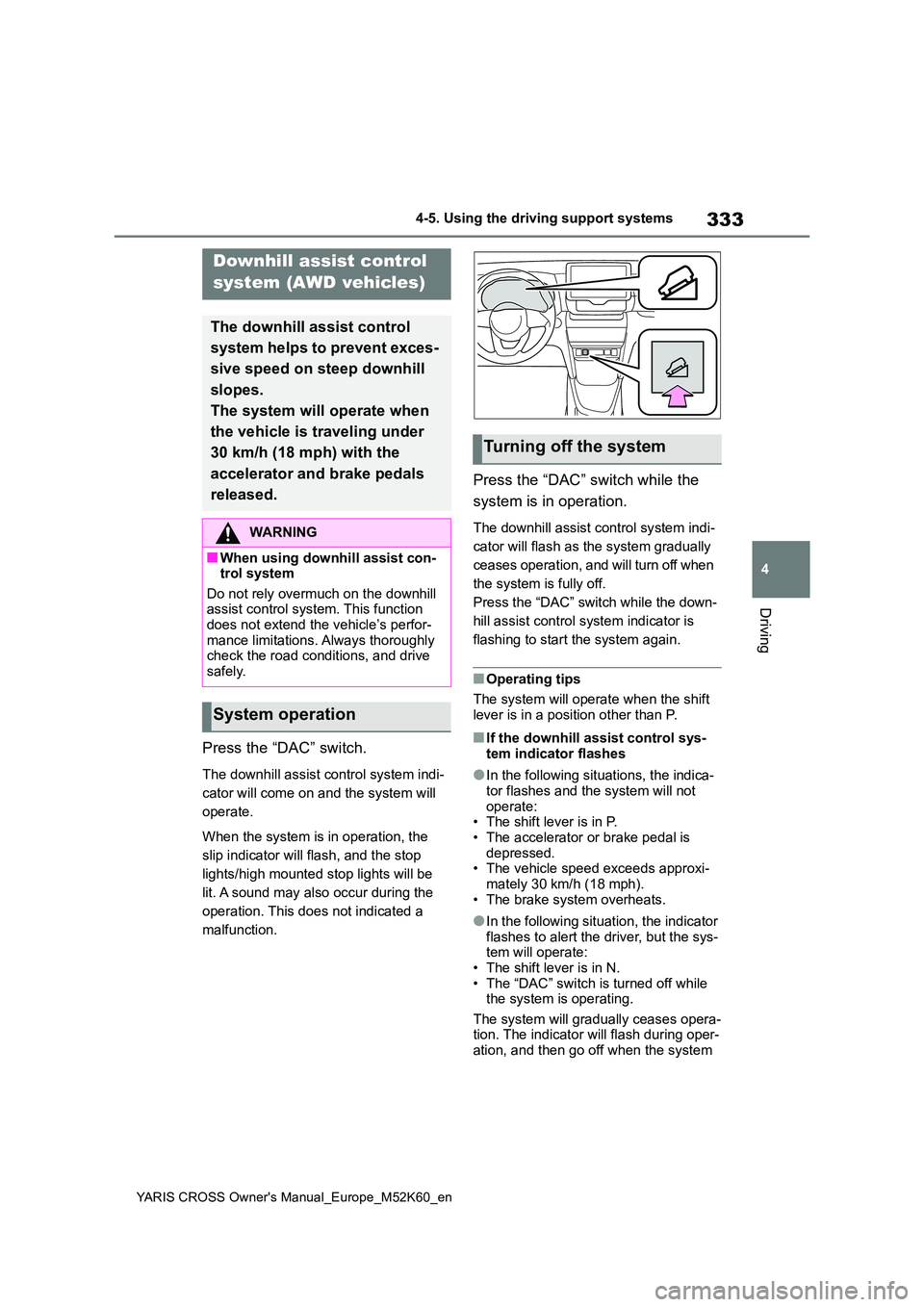
333
4
YARIS CROSS Owner's Manual_Europe_M52K60_en
4-5. Using the driving support systems
Driving
Press the “DAC” switch.
The downhill assist control system indi-
cator will come on and the system will
operate.
When the system is in operation, the
slip indicator will flash, and the stop
lights/high mounted stop lights will be
lit. A sound may also occur during the
operation. This does not indicated a
malfunction.
Press the “DAC” switch while the
system is in operation.
The downhill assist control system indi-
cator will flash as the system gradually
ceases operation, and will turn off when
the system is fully off.
Press the “DAC” switch while the down-
hill assist control system indicator is
flashing to start the system again.
■Operating tips
The system will operate when the shift lever is in a position other than P.
■If the downhill assist control sys-tem indicator flashes
●In the following situations, the indica-tor flashes and the system will not
operate: • The shift lever is in P.• The accelerator or brake pedal is
depressed. • The vehicle speed exceeds approxi-mately 30 km/h (18 mph).
• The brake system overheats.
●In the following situation, the indicator flashes to alert the driver, but the sys-tem will operate:
• The shift lever is in N. • The “DAC” switch is turned off while the system is operating.
The system will gradually ceases opera- tion. The indicator will flash during oper-ation, and then go off when the system
Downhill assist control
system (AWD vehicles)
The downhill assist control
system helps to prevent exces-
sive speed on steep downhill
slopes.
The system will operate when
the vehicle is traveling under
30 km/h (18 mph) with the
accelerator and brake pedals
released.
WARNING
■When using downhill assist con- trol system
Do not rely overmuch on the downhill assist control system. This function does not extend the vehicle’s perfor-
mance limitations. Always thoroughly check the road conditions, and drive safely.
System operation
Turning off the system
Page 336 of 650

334
YARIS CROSS Owner's Manual_Europe_M52K60_en
4-5. Using the driving support systems
is fully off.
■When the downhill assist control
system is operated continuously
This may cause the brake actuator to overheat. In this case, the downhill
assist control system will stop operating, a buzzer will sound and the downhill assist control system indicator will start
flashing, and “Traction Control Turned OFF” will be shown on the multi-infor-mation display. Refrain from using the
system until the downhill assist control system indicator stays on and “Traction Control Turned OFF” the message goes
off. (The vehicle can be driven normally during this time.)
■Sounds and vibrations caused by the downhill assist control system
●A sound may be heard from the engine compartment when the hybrid
system is started or just after the vehi- cle begins to move. This sound does not indicate that a malfunction has
occurred in downhill assist control system.
●Either of the following conditions may occur when the downhill assist control system is operating. None of these
are indicators that a malfunction has occurred.• Vibrations may be felt through the
vehicle body and steering. • A motor sound may be heard after the vehicle comes to a stop.
■System malfunction
In the following cases, have your vehicle checked by any authorized Toyota retailer or Toyota authorized repairer, or
any reliable repairer.
●The downhill assist control system
indicator does not come on when the power switch is turned to ON.
●The downhill assist control system indicator does not come on when the “DAC” switch is pressed.
●The slip indicator light comes on.
WARNING
■The system may not operate on the following surfaces, which
may lead to an accident causing death or serious injury
●Slippery surfaces such as wet or
muddy roads
●Icy surface
●Unpaved roads
Page 338 of 650
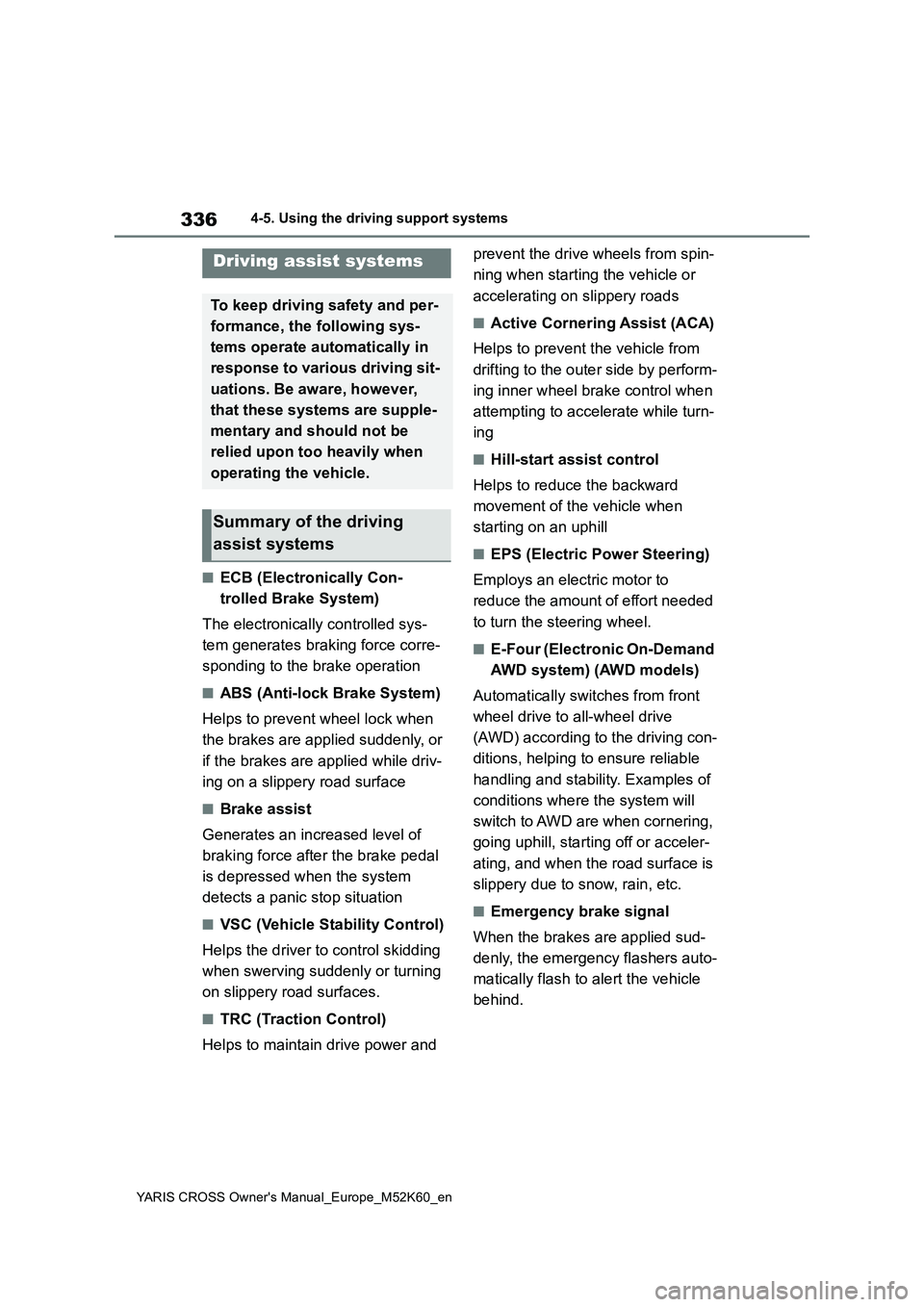
336
YARIS CROSS Owner's Manual_Europe_M52K60_en
4-5. Using the driving support systems
■ECB (Electronically Con-
trolled Brake System)
The electronically controlled sys-
tem generates braking force corre-
sponding to the brake operation
■ABS (Anti-lock Brake System)
Helps to prevent wheel lock when
the brakes are applied suddenly, or
if the brakes are applied while driv-
ing on a slippery road surface
■Brake assist
Generates an increased level of
braking force after the brake pedal
is depressed when the system
detects a panic stop situation
■VSC (Vehicle Stability Control)
Helps the driver to control skidding
when swerving suddenly or turning
on slippery road surfaces.
■TRC (Traction Control)
Helps to maintain drive power and
prevent the drive wheels from spin-
ning when starting the vehicle or
accelerating on slippery roads
■Active Cornering Assist (ACA)
Helps to prevent the vehicle from
drifting to the outer side by perform-
ing inner wheel brake control when
attempting to accelerate while turn-
ing
■Hill-start assist control
Helps to reduce the backward
movement of the vehicle when
starting on an uphill
■EPS (Electric Power Steering)
Employs an electric motor to
reduce the amount of effort needed
to turn the steering wheel.
■E-Four (Electronic On-Demand
AWD system) (AWD models)
Automatically switches from front
wheel drive to all-wheel drive
(AWD) according to the driving con-
ditions, helping to ensure reliable
handling and stability. Examples of
conditions where the system will
switch to AWD are when cornering,
going uphill, starting off or acceler-
ating, and when the road surface is
slippery due to snow, rain, etc.
■Emergency brake signal
When the brakes are applied sud-
denly, the emergency flashers auto-
matically flash to alert the vehicle
behind.
Driving assist systems
To keep driving safety and per-
formance, the f ollowing sys-
tems operate automatically in
response to various driving sit-
uations. Be aware, however,
that these systems are supple-
mentary and should not be
relied upon too heavily when
operating the vehicle.
Summary of the driving
assist systems
Page 340 of 650
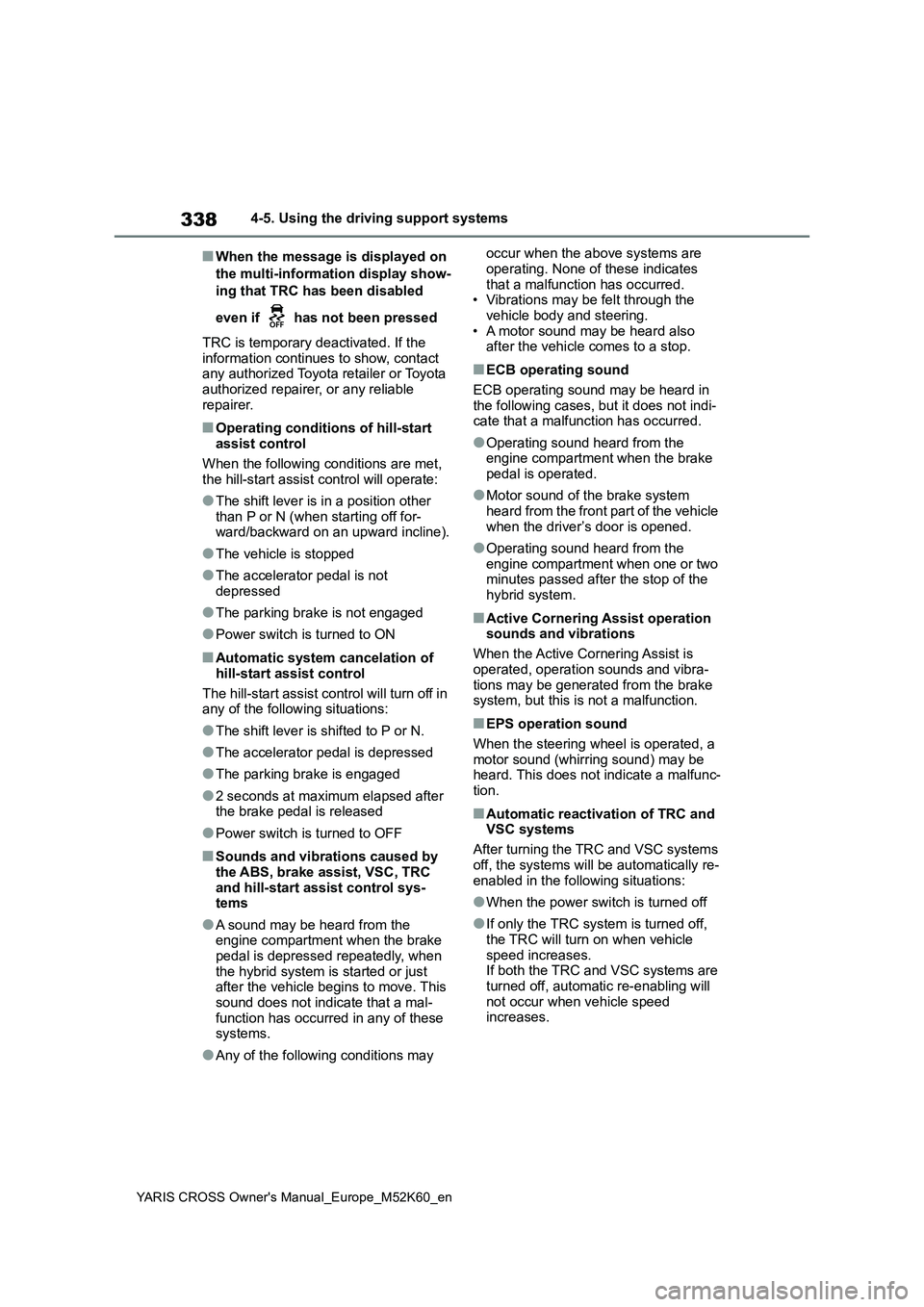
338
YARIS CROSS Owner's Manual_Europe_M52K60_en
4-5. Using the driving support systems
■When the message is displayed on
the multi-information display show-
ing that TRC has been disabled
even if has not been pressed
TRC is temporary deactivated. If the information continues to show, contact any authorized Toyota retailer or Toyota
authorized repairer, or any reliable repairer.
■Operating conditions of hill-start assist control
When the following conditions are met, the hill-start assist control will operate:
●The shift lever is in a position other than P or N (when starting off for-ward/backward on an upward incline).
●The vehicle is stopped
●The accelerator pedal is not depressed
●The parking brake is not engaged
●Power switch is turned to ON
■Automatic system cancelation of
hill-start assist control
The hill-start assist control will turn off in any of the following situations:
●The shift lever is shifted to P or N.
●The accelerator pedal is depressed
●The parking brake is engaged
●2 seconds at maximum elapsed after the brake pedal is released
●Power switch is turned to OFF
■Sounds and vibrations caused by the ABS, brake assist, VSC, TRC
and hill-start assist control sys- tems
●A sound may be heard from the engine compartment when the brake pedal is depressed repeatedly, when
the hybrid system is started or just after the vehicle begins to move. This sound does not indicate that a mal-
function has occurred in any of these systems.
●Any of the following conditions may
occur when the above systems are
operating. None of these indicates that a malfunction has occurred.• Vibrations may be felt through the
vehicle body and steering. • A motor sound may be heard also after the vehicle comes to a stop.
■ECB operating sound
ECB operating sound may be heard in the following cases, but it does not indi-cate that a malfunction has occurred.
●Operating sound heard from the engine compartment when the brake
pedal is operated.
●Motor sound of the brake system
heard from the front part of the vehicle when the driver’s door is opened.
●Operating sound heard from the engine compartment when one or two minutes passed after the stop of the
hybrid system.
■Active Cornering Assist operation sounds and vibrations
When the Active Cornering Assist is
operated, operation sounds and vibra- tions may be generated from the brake system, but this is not a malfunction.
■EPS operation sound
When the steering wheel is operated, a motor sound (whirring sound) may be heard. This does not indicate a malfunc-
tion.
■Automatic reactivation of TRC and VSC systems
After turning the TRC and VSC systems
off, the systems will be automatically re- enabled in the following situations:
●When the power switch is turned off
●If only the TRC system is turned off,
the TRC will turn on when vehicle speed increases.If both the TRC and VSC systems are
turned off, automatic re-enabling will not occur when vehicle speed increases.
Page 343 of 650
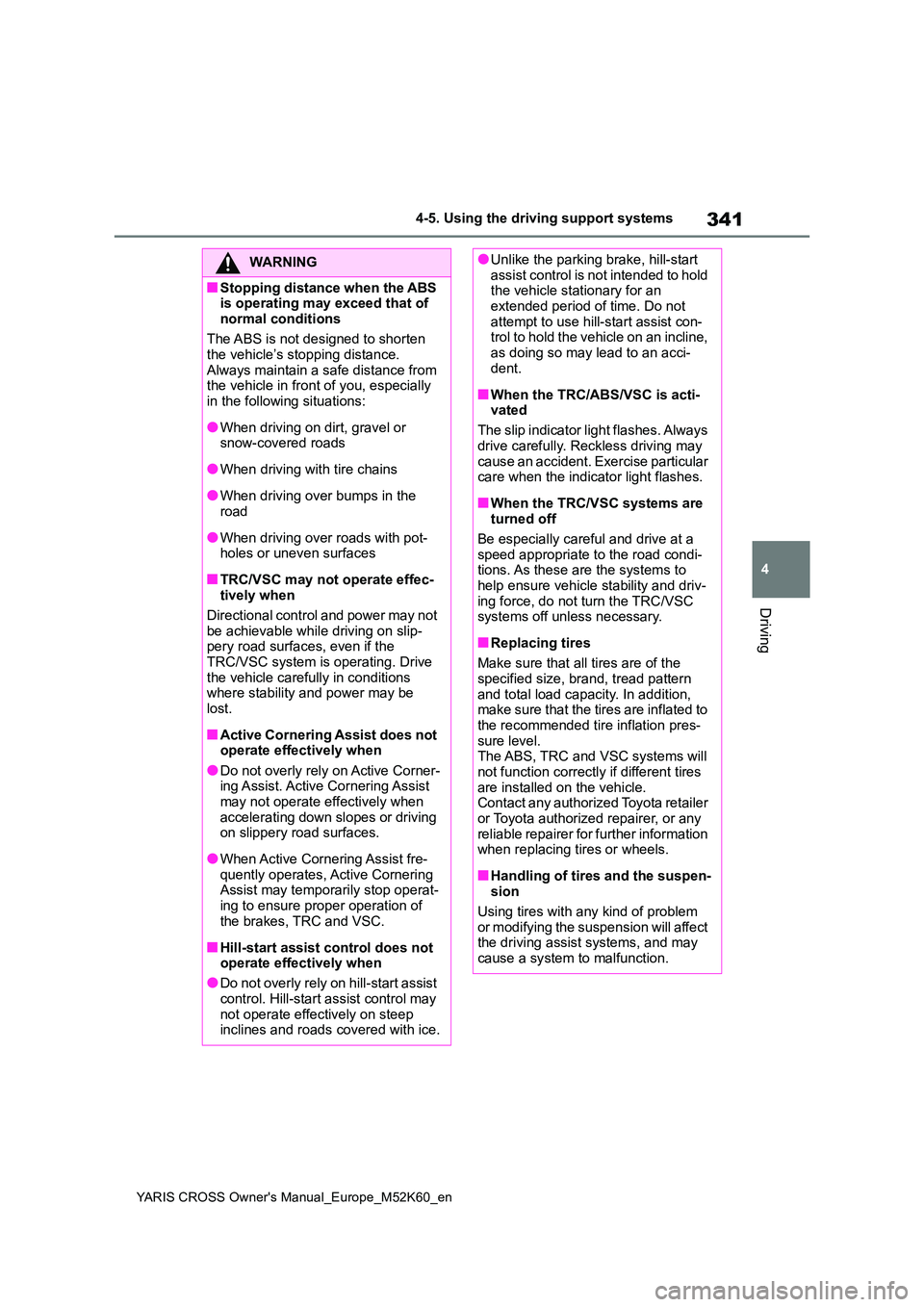
341
4
YARIS CROSS Owner's Manual_Europe_M52K60_en
4-5. Using the driving support systems
Driving
WARNING
■Stopping distance when the ABS is operating may exceed that of
normal conditions
The ABS is not designed to shorten the vehicle’s stopping distance.
Always maintain a safe distance from the vehicle in front of you, especially in the following situations:
●When driving on dirt, gravel or snow-covered roads
●When driving with tire chains
●When driving over bumps in the road
●When driving over roads with pot-holes or uneven surfaces
■TRC/VSC may not operate effec-tively when
Directional control and power may not
be achievable while driving on slip- pery road surfaces, even if the TRC/VSC system is operating. Drive
the vehicle carefully in conditions where stability and power may be lost.
■Active Cornering Assist does not operate effectively when
●Do not overly rely on Active Corner-ing Assist. Active Cornering Assist may not operate effectively when
accelerating down slopes or driving on slippery road surfaces.
●When Active Cornering Assist fre-quently operates, Active Cornering Assist may temporarily stop operat-
ing to ensure proper operation of the brakes, TRC and VSC.
■Hill-start assist control does not operate effectively when
●Do not overly rely on hill-start assist
control. Hill-start assist control may not operate effectively on steep inclines and roads covered with ice.
●Unlike the parking brake, hill-start assist control is not intended to hold the vehicle stationary for an
extended period of time. Do not attempt to use hill-start assist con-trol to hold the vehicle on an incline,
as doing so may lead to an acci- dent.
■When the TRC/ABS/VSC is acti-vated
The slip indicator light flashes. Always
drive carefully. Reckless driving may cause an accident. Exercise particular care when the indicator light flashes.
■When the TRC/VSC systems are turned off
Be especially careful and drive at a speed appropriate to the road condi-tions. As these are the systems to
help ensure vehicle stability and driv- ing force, do not turn the TRC/VSC systems off unless necessary.
■Replacing tires
Make sure that all tires are of the
specified size, brand, tread pattern and total load capacity. In addition, make sure that the tires are inflated to
the recommended tire inflation pres- sure level.The ABS, TRC and VSC systems will
not function correctly if different tires are installed on the vehicle.Contact any authorized Toyota retailer
or Toyota authorized repairer, or any reliable repairer for further information when replacing tires or wheels.
■Handling of tires and the suspen-sion
Using tires with any kind of problem or modifying the suspension will affect the driving assist systems, and may
cause a system to malfunction.
Page 346 of 650

344
YARIS CROSS Owner's Manual_Europe_M52K60_en
4-6. Driving tips
a traffic jam, gently release the
brake pedal to allow the vehicle to
move forward slightly while avoid-
ing overuse of the accelerator
pedal. Doing so can help control
excessive gasoline consumption.
Control and maintain the vehicle at
a constant speed. Before stopping
at a toll booth or similar, allow
plenty of time to release the accel-
erator and gently apply the brakes.
A greater amount of electrical
energy can be regenerated when
slowing down.
Use the air conditioning only when
necessary. Doing so can help
reduce excessive gasoline con-
sumption.
In summer: When the ambient tem-
perature is high, use the recircu-
lated air mode. Doing so will help to
reduce the burden on the air condi-
tioning system and reduce fuel con-
sumption as well.
In winter: Because the gasoline
engine will not automatically cut out
until it and the interior of the vehicle
are warm, it will consume fuel. Also,
fuel consumption can be improved
by avoiding overuse of the heater.
Make sure to check the tire inflation
pressure frequently. Improper tire
inflation pressure can cause poor
fuel economy.
Also, as snow tires can cause large
amounts of friction, their use on dry
roads can lead to poor fuel econ-
omy. Use tires that are appropriate
for the season.
Carrying heavy luggage will lead to
poor fuel economy. Avoid carrying
unnecessary luggage. Installing a
large roof rack will also cause poor
fuel economy.
Since the gasoline engine starts up
and cuts out automatically when
cold, warming up the engine is
unnecessary. Moreover, frequently
driving short distances will cause
the engine to repeatedly warm up,
which can lead to excess fuel con-
sumption.
Highway driving
Air conditioning
Checking tire inflation pres-
sure
Luggage
Warming up before driving
Page 370 of 650
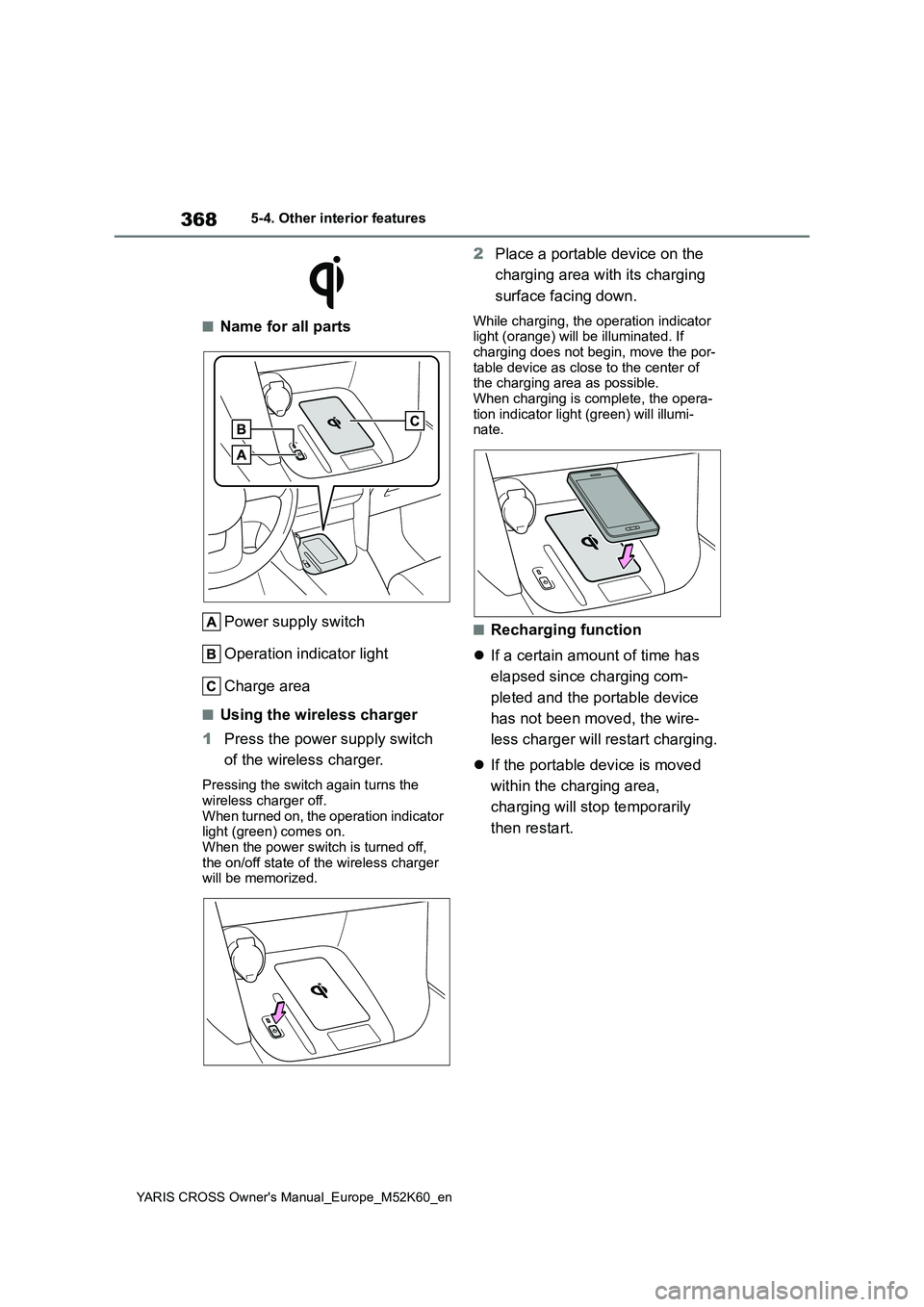
368
YARIS CROSS Owner's Manual_Europe_M52K60_en
5-4. Other interior features
■Name for all parts
Power supply switch
Operation indicator light
Charge area
■Using the wireless charger
1 Press the power supply switch
of the wireless charger.
Pressing the switch again turns the wireless charger off.
When turned on, the operation indicator light (green) comes on. When the power switch is turned off,
the on/off state of the wireless charger will be memorized.
2 Place a portable device on the
charging area with its charging
surface facing down.
While charging, the operation indicator light (orange) will be illuminated. If charging does not begin, move the por-
table device as close to the center of the charging area as possible.When charging is complete, the opera-
tion indicator light (green) will illumi- nate.
■Recharging function
If a certain amount of time has
elapsed since charging com-
pleted and the portable device
has not been moved, the wire-
less charger will restart charging.
If the portable device is moved
within the charging area,
charging will stop temporarily
then restart.